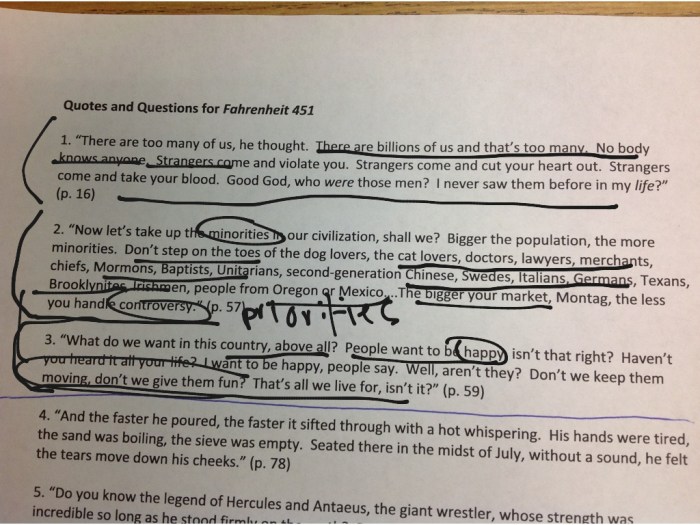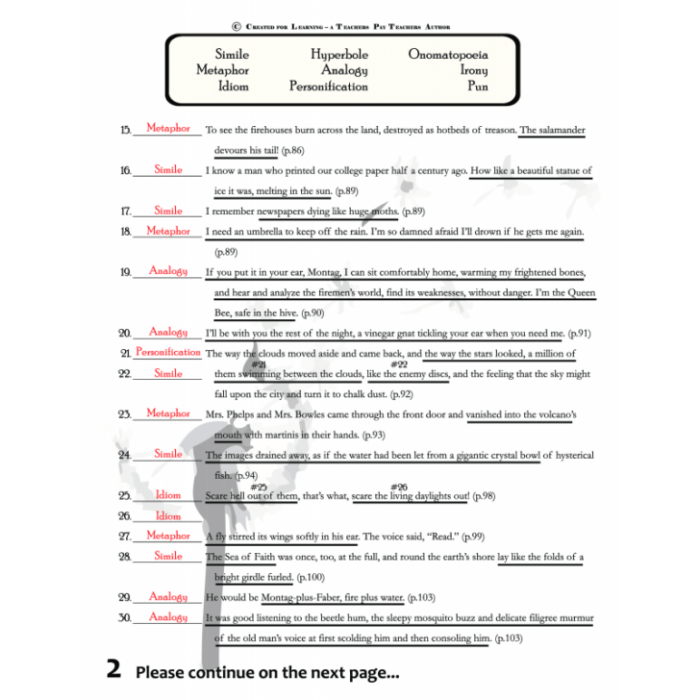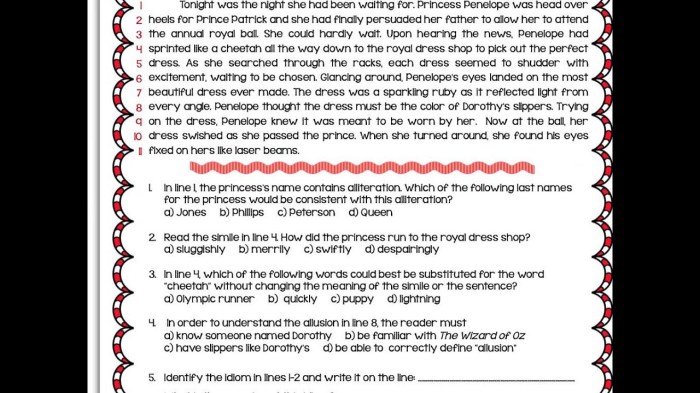Figurative language in Part 2 of Fahrenheit 451 enriches the novel’s narrative by enhancing imagery, conveying themes, and humanizing abstract concepts. Metaphors, similes, personification, hyperbole, and symbolism contribute to the reader’s immersive experience and understanding of the characters and their motivations.
The use of metaphors in Part 2 of Fahrenheit 451 is particularly noteworthy, as they provide a deeper insight into the novel’s themes. For instance, the comparison of Montag’s hands to “fiery birds” symbolizes his inner turmoil and the destructive power of censorship.
Similes, on the other hand, create vivid imagery and enhance the atmosphere of the novel. Bradbury’s description of the city as “a vast, dim furnace” conveys the oppressive and dystopian nature of the society depicted in the novel.
Figurative Language in Part 2 of Fahrenheit 451

In Part 2 of Fahrenheit 451, Ray Bradbury employs a rich array of figurative language to enhance the novel’s themes, characterization, and overall impact. Metaphors, similes, personification, hyperbole, imagery, and symbolism all play vital roles in creating a vivid and thought-provoking reading experience.
Metaphors, Figurative language in part 2 of fahrenheit 451
Bradbury uses metaphors to create vivid comparisons and convey abstract ideas. For instance, the “sea of faces” at the Hound’s Tooth Bar represents the conformity and anonymity of society. The “white hand” of the mechanical hound symbolizes the oppressive power of technology.
These metaphors help readers visualize and understand the novel’s central themes.
Similes
Similes contribute to the novel’s imagery and atmosphere. For example, Montag’s hands are described as “white like snow,” emphasizing his fear and vulnerability. The firemen’s helmets are compared to “black flowers,” suggesting their destructive nature. These similes enhance the reader’s sensory experience and deepen their understanding of the characters and their motivations.
Personification
Personification is used to humanize abstract concepts and objects. For instance, the city is described as “breathing” and the wind is said to “scream.” These personifications make the novel’s world more relatable and emotionally impactful. Readers can connect with the characters’ experiences on a personal level.
Hyperbole
Hyperbole creates emphasis and exaggeration. For example, Montag’s heart is described as “beating like a drum.” The firemen are said to “burn everything in their path.” These hyperboles contribute to the novel’s satirical and dystopian elements, highlighting the absurdity and dangers of censorship and conformity.
Imagery
Bradbury employs a variety of sensory imagery to immerse readers in the novel’s world. Visual imagery, such as the “fiery tongues” of the flames, creates a vivid picture in the reader’s mind. Auditory imagery, like the “crackling” of the fire, enhances the atmosphere.
Tactile imagery, such as the “cold” of the rain, allows readers to experience the physical sensations of the characters. Olfactory imagery, like the “smell of kerosene,” adds depth and authenticity to the setting.
Symbolism
Bradbury uses symbols to represent deeper meanings and ideas. For instance, the phoenix represents rebirth and renewal. The book symbolizes knowledge and freedom. These symbols enhance the novel’s thematic depth and complexity, inviting readers to contemplate the broader implications of the story.
Detailed FAQs: Figurative Language In Part 2 Of Fahrenheit 451
What is the significance of the metaphor of “fiery birds” in Part 2 of Fahrenheit 451?
The metaphor of “fiery birds” symbolizes Montag’s inner turmoil and the destructive power of censorship.
How does Bradbury use similes to enhance the atmosphere of the novel?
Bradbury uses similes to create vivid imagery and convey the oppressive and dystopian nature of the society depicted in the novel, such as describing the city as “a vast, dim furnace.”
What is the effect of personification in Part 2 of Fahrenheit 451?
Personification humanizes abstract concepts and objects, enhancing the novel’s emotional impact and relatability.

